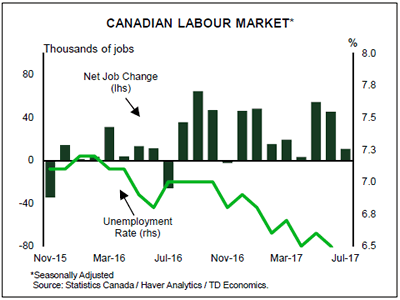U.S. Highlights
- Substantial positive revisions to Q2 US GDP indicated stronger momentum going into the third quarter than previously thought, with Hurricane Harvey expected to shave 0.1-0.4 ppts. off growth in Q3.
- Inflation continued to be stubbornly elusive in July but we still expect a hike by the Fed in December, given that inflation will likely strengthen in the coming months.
- Global economies continue to strengthen alongside the US, with China’s Caixin manufacturing PMI expanding to its highest level in six months in August, led by strong foreign demand for goods.
Canadian Highlights
- Hurricane Harvey is impacting Canada via higher gasoline prices and lower crude oil prices. On average, prices at the pump have jumped by 10 cents per litre this week, while the WTI-WCS spread widened by 20% to $11.75.
- Real GDP grew by 4.5% in the second quarter, marking the best 4-quarter performance since 2006. Growth of 0.3% in June provides a strong handoff for Q3.
- The CFIB Business Barometer fell for a third consecutive month in August, suggesting that the robust pace of growth is unlikely to last.
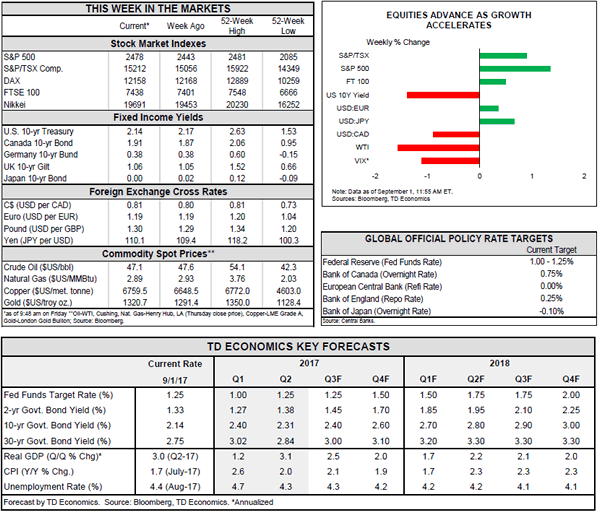
U.S. – Inflation Remains Elusive in Q3
It was a busy week for data this week in the US, with investors looking for clues on how the economy is performing and whether it warrants further tightening. Substantial positive revisions to Q2 US GDP indicated stronger momentum going into the third quarter than previously thought, with Q2 growth revised up to a robust 3.0% annualized. However, Hurricane Harvey, which made landfall in Southeast Texas last week, looks to be a transitory obstruction for the economy in Q3. The storm is expected to shave 0.1-0.4 ppts. off growth but a similar acceleration in Q4 should leave the second half of the year unchanged on balance. Harvey will also necessitate the passage of a disaster assistance package by the federal government. On that note, until further details surrounding policy and tax reform materialize, investors will remain fixated on economic data.
Evidence to support the Fed’s tightening path was mixed as the week progressed. July’s personal income & spending report highlighted the pivotal role of the consumer in the economic recovery, with strength in real spending apparent. But the missing piece of the puzzle continues to be inflation, which has been stubbornly elusive during this recovery. And this was compounded by Friday’s jobs report that indicated relatively subdued wage growth -a trend that does not bode well for the inflation outlook (Chart 1). We still expect a hike by the Fed in December, but expect that inflation will materialize in the coming months. Manufacturing activity displayed pronounced strength in hiring in August while the positive ISM reading for the month prefaces continued strength in the sector going forward (Chart 2). As such, investor confidence in the American economy remains intact, which alongside weaker inflation has supported US equities.
Asian economies have also shown increased momentum lately. Case in point, China’s Caixin manufacturing PMI expanded to its highest level in six months in August, led by strong demand for exports. That’s a welcome development given concerns regarding the economy’s slowing growth this year and the role that government debt has had in stimulating growth. Other Asian economies echoed this constructive tone, leading the MSCI Asia Pacific Index to a level just shy of a decade high.
European equities also reaped the benefits of improving economic data. Despite August’s strong inflation reading in the Eurozone, the ECB is expected to leave its policy stance unchanged at next week’s meeting. The committee’s monetary policy path is complicated by the differing rates of recovery within the Eurozone. Germany and Northern Europe have displayed strong growth, while Southern economies including Greece and Italy are still grappling with slow employment growth and an elevated euro that is proving to be a barrier to export growth.
With a relatively quiet data release schedule for next week, investors will turn their attention to the array of speeches being made by FOMC members. Of central importance will be their views on the soft inflation and wage prints in recent data. Ultimately, we do not expect these developments to dissuade the Fed from beginning balance sheet normalization in the coming weeks, but some improvement on the inflation front is likely to be needed before another rate hike by the Fed.
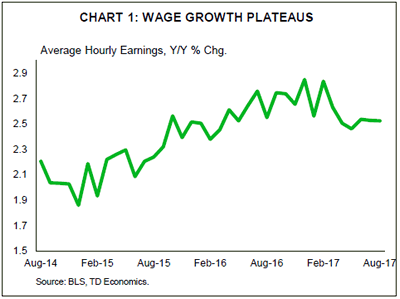
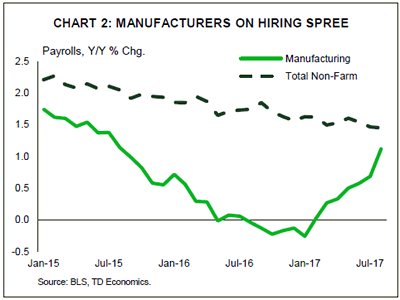
Canada – Feeling The Impact Of Harvey
This week started off with Hurricane Harvey in the spotlight, as it barreled across Southeast Texas and Louisiana causing massive flooding and destruction in the area. While far removed from the devastation, Canada was not left unscathed by the tropical storm. Harvey has wreaked havoc on the energy industry – shutting in roughly a tenth of production and a third of all U.S. oil refining capacity – with the outages affecting the Canadian economy. The most visible impact has been on gasoline prices, which have risen on average by about 10 cents per litre since Monday, reaching the highest level seen in two years. The increase has been even more pronounced in some Canadian cities. Canada imports some refined products from the U.S., and the market is tightly integrated, suggesting no relief for drivers over the near-term. In fact, further increases expected over the weekend could push pump prices up to a 3-year high. It is too early to tell how long the flooding in Texas will persist, or how long refineries will be shut down. But, it is safe to believe that drivers will be facing elevated pump prices for several weeks.
Another impact has been on the Canadian oil sands, which have seen a drop in demand from the Gulf coast refineries. This has weighed on the price they receive for their heavy oil. The spread between Western Canadian Select – the benchmark for heavy oil – and WTI (which fell as expectations for lower refinery demand outweighed the oil production shutdowns) widened by 25% to $11.75 this week, marking the largest discount since March. Moreover, U.S. supplies of oil sands diluent (which is used to dilute bitumen so it can flow through pipelines) has been curtailed given a pipeline shutdown. Roughly a third of diluent used by oil sands producers comes from south of the border. While demand for Canadian oil may be weak in the near term, it will likely rebound once refining resumes.
On a brighter note, the highlight of the week for the Canadian economy was yet another stellar GDP report. Although backward looking, it showed that the economy expanded by a whopping 4.5% in the second quarter, marking the fourth straight quarter of robust growth. In fact, this is Canada’s best four-quarter performance since 2006. What’s more, economic activity grew by a solid 0.3% in June, providing a strong handoff for the third quarter.
That said, a repeat performance of the first half of the year is unlikely going forward. The small business barometer showed that optimism among businesses fell in August for a third consecutive month. This is typically a leading indicator, with these recent declines and weakness in forward looking indicators pointing to a deceleration in economic activity. Indeed, early tracking does suggest that economic growth will slow in the third quarter. However, it is expected to remain at an above-trend pace near 3%, which could push the economy into excess territory. Following the GDP report, odds of a rate hike in September edged up. However, given that there has been no communication from the Bank of Canada since its last meeting, we would be surprised to see a move next week. We do expect the rate hiking cycle to continue though, with a 25 basis point hike in October, followed by two more in 2018.
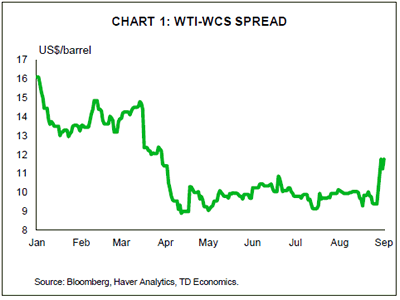
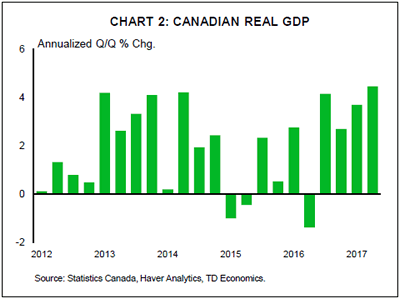
Canada: Upcoming Key Economic Releases
Canadian International Trade – July
Release Date: September 6, 2017
Previous Result: -$3.60bn
TD Forecast: -$3.30bn
Consensus: -$3.35bn
The goods trade deficit is forecast to narrow modestly to $3.3bn in July on a combination of weaker import and export activity. CAD appreciation should act as a driving force behind the pullback on both sides of the ledger after the loonie soared by roughly 4.5% during the month, though there are also a few one off events which could make for a noisy report. Gold bullion imports surged by 40% m/m in June and a full correction should single handedly shave $400m from the deficit. The stronger Canadian dollar should feed through to softer trade activity where FX passthrough is most prominent, namely agriculture and other unrefined resources, of which Canada is a net exporter. Motor vehicle exports should come under pressure in light of declining US demand, a pullback in Canadian production and downward pricing pressures. Imports however should remain well supported by a resilient Canadian consumer.
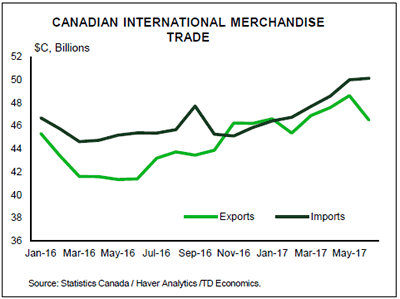
Canadian Employment – August
Release Date: September 8, 2017
Previous Result: 10.9k, unemployment rate: 6.3%
TD Forecast: 10k, unemployment rate: 6.3%
Consensus: 15k, unemployment rate: 6.3%
The Canadian economy is forecast to add 10k jobs in August, little changed from the prior month but subdued in comparison to the lofty pace in Q2. Job growth should skew towards public and private employees, which would coincide with a pullback in self-employment after a strong two months. Last month’s 35k gain in full time employment was in line with the six-month trend and while we could see some moderation from these levels, there is no catalyst to suggest an outright correction. The unemployment rate should hold steady at 6.3%, a record low for the current cycle, though the risks lean a 6.4% print should last month’s pullback in labour force participation correct. Wage growth, currently sitting at a subdued 1.2% y/y, should a modest pickup on the heels of the tightening in labour market conditions and muted base-effects from last August.
